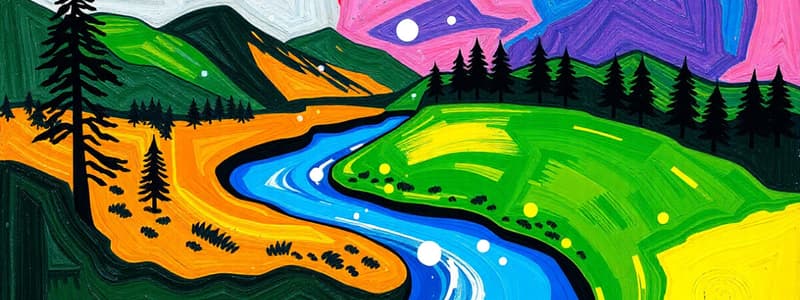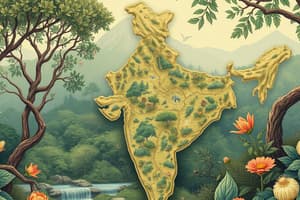Podcast
Questions and Answers
What covers about three-fourths of the total surface of the earth?
What covers about three-fourths of the total surface of the earth?
- Soil
- Water (correct)
- Air
- Land
What type of natural disaster are low-lying areas particularly susceptible to?
What type of natural disaster are low-lying areas particularly susceptible to?
- Earthquakes
- Tsunamis
- Landslides
- Flooding (correct)
Which physical features are considered most suitable for human habitation?
Which physical features are considered most suitable for human habitation?
- Plains and river valleys (correct)
- Deserts
- Mountains
- Lakes and rivers
What does the term 'domestic' in 'Domestic violence' encompass?
What does the term 'domestic' in 'Domestic violence' encompass?
What is an example of community land?
What is an example of community land?
What is required for a bill to become an Act?
What is required for a bill to become an Act?
What is the primary use of land in India?
What is the primary use of land in India?
Which of the following is considered a form of abuse against women?
Which of the following is considered a form of abuse against women?
Which institution serves as the highest law-making body in the country?
Which institution serves as the highest law-making body in the country?
Which country is predominantly covered with forest land?
Which country is predominantly covered with forest land?
How are representatives to the parliament chosen?
How are representatives to the parliament chosen?
What primarily makes ocean water unfit for human consumption?
What primarily makes ocean water unfit for human consumption?
Which soil conservation method is commonly used in coastal and dry regions?
Which soil conservation method is commonly used in coastal and dry regions?
After the collapse of indigo production in Bengal, which state did planters primarily relocate their operations to?
After the collapse of indigo production in Bengal, which state did planters primarily relocate their operations to?
Which statements are TRUE regarding the Mahalwari system?
Which statements are TRUE regarding the Mahalwari system?
In which year did the Great Famine take place in Bengal?
In which year did the Great Famine take place in Bengal?
Which term is closest in meaning to 'mahal' within the context of the Mahalwari system?
Which term is closest in meaning to 'mahal' within the context of the Mahalwari system?
What was the name of the Settlement system introduced in the Madras and Bombay presidencies to enhance land revenue?
What was the name of the Settlement system introduced in the Madras and Bombay presidencies to enhance land revenue?
Which of the following crops is associated with the state of Punjab?
Which of the following crops is associated with the state of Punjab?
Who was responsible for the introduction of the Mahalwari system?
Who was responsible for the introduction of the Mahalwari system?
Which crop produced a rich blue color, significant for its dye?
Which crop produced a rich blue color, significant for its dye?
Flashcards are hidden until you start studying
Study Notes
Geography: Land, Soil, Water, Natural Vegetation and Wildlife Resources
- Water covers approximately three-fourths of Earth's surface.
- Low-lying areas are particularly vulnerable to flooding.
- Plains and river valleys offer the best living conditions.
- Community land examples include the Sunderban forests.
- A significant portion of land in India is devoted to cultivation.
- Brazil and the USA have extensive forest coverage.
- Ocean water's salinity renders it unfit for human consumption.
- Contour ploughing is an essential method for soil conservation.
Threats to Soil
- Major threats to soil include erosion and pollution.
- Freshwater constitutes about 3% of Earth's total water resources.
- Soil color, texture, and chemical properties depend on its mineral composition.
- Weathering and humus levels are influenced by organic matter and climate.
History: Ruling the Countryside
- Indigo plantation operators in Bengal moved their activities to Bihar after production collapse.
- The Mahalwari system imposed collective tax responsibility on landlords.
- The Great Famine in Bengal occurred in 1770.
- “Mahal” refers to a collection of village plots for tax assessment.
- The Ryotwari Settlement System was introduced in the Madras and Bombay presidencies.
Agriculture and Crop Production
- Jute is primarily associated with Bengal.
- Wheat is predominantly grown in the United Provinces (Uttar Pradesh).
- Rice is a staple crop in Bengal, while sugarcane is cultivated in Maharashtra.
- Tea plantations mainly thrive in Assam.
- Cotton is chiefly grown in Punjab.
Social & Political: Parliament and Making of Laws
- "Domestic" in 'Domestic violence' refers to shared households with husbands.
- A bill becomes an Act only after receiving presidential assent.
- Abuse encompasses economic, sexual, and verbal forms.
- The Parliament is the highest law-making body, comprising the Lok Sabha and Rajya Sabha.
- Representatives in Parliament are elected by the people.
Legal and Political Framework
- All individuals in independent India are equal before the law.
- Colonial law is characterized as oppressive and discriminatory.
- Indian judges increasingly contribute to legislative processes.
- Citizens play a vital role in voicing concerns that laws address.
Definitions and Functions
- The opposition party refers to political groups not in government.
- A coalition government is formed by multiple parties to achieve a parliamentary majority.
- Parliament’s approval is necessary for laws to be enacted.
- The two Houses of Parliament are the Lok Sabha and Rajya Sabha.
- Parliament sessions commence with a formal address, outlining agendas.
- A constituency is a defined area represented by a member of Parliament.
- The Speaker presides over the Lok Sabha, maintaining order during proceedings.
- The main function of Parliament is to formulate and enact laws.
- The nationalist movement advocated for universal suffrage to empower citizens.
Studying That Suits You
Use AI to generate personalized quizzes and flashcards to suit your learning preferences.




